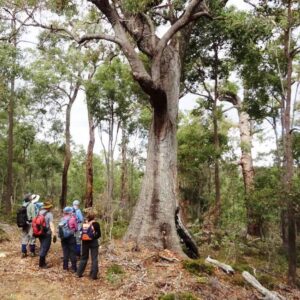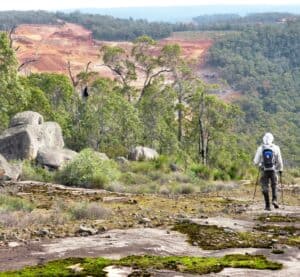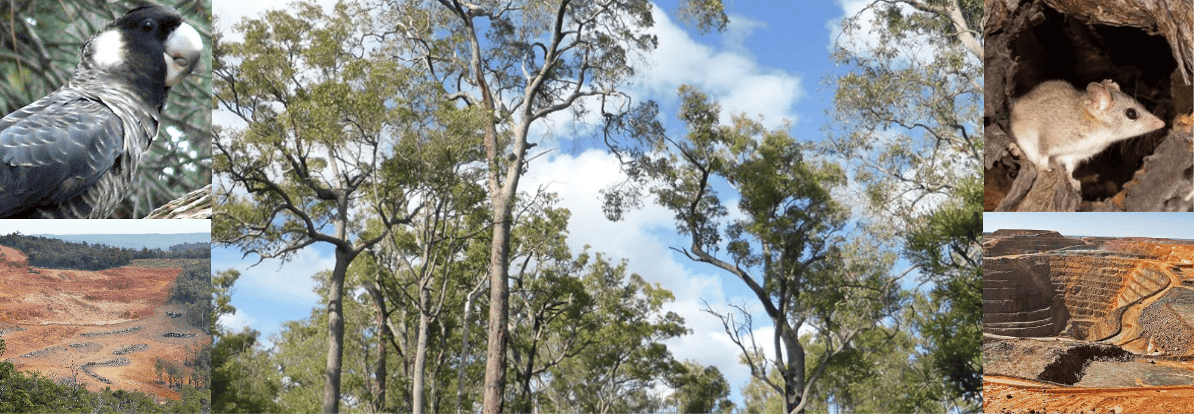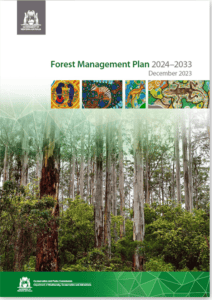Four media announcements around year-end 2023 appeared to be good news for Western Australia’s native forests as we entered 2024:
- The Environmental Protection Agency (EPA) announced in mid December it will be publicly assessing Alcoa’s environmental management plans for their current Huntly and Willowdale bauxite mining operations in the Darling Range. These will be the first such assessments in 60 years.
 The State Government also announced that the finalised Forest Management Plan 2024–33 (FMP) was to come into effect on 1 January 2024. This signalled the end of native logging in WA and a commitment to add more than 4000 sq km of native forests as nature reserves, national parks and conservation parks.
The State Government also announced that the finalised Forest Management Plan 2024–33 (FMP) was to come into effect on 1 January 2024. This signalled the end of native logging in WA and a commitment to add more than 4000 sq km of native forests as nature reserves, national parks and conservation parks.
In its prior, September 2023 report to the Minister, recommending approval of the FMP, the EPA urged (in part):- the need for timeliness with respect to adding areas to the conservation estate
- the FMP implementation priorities should include protection of the Northern Jarrah Forest to achieve regional forest agreement reserve targets and (in part) expansion of existing reserves and ecological linkages.
- consideration should be given to the mapping of potential areas for protection undertaken by DJ Martin in conjunction with the Beeliar and Leeuwin groups (see the “Forests Atlas”).
- Chalice Mining, which has ambitions to mine within Julimar State Forest and the proposed Conservation Park, announced a 40% reduction of its planned 2024 spending due to the recently tumbling global prices for battery and ‘clean energy’ metals. Meanwhile the petition to state parliament for the reclassification of Julimar State Forest to national park status gained the support of over 2800 signatories.
- Alcoa announced in January that it will be shutting down its Kwinana alumina refinery by September this year.
The first two items above might suggest WA is at last showing overdue commitment to proper custodianship of our native forests. The other two items could suggest Chalice Mining will delay their ambitions for mining at Julimar and that Alcoa, under pressure, is beginning a retreat from its bauxite mining operations in the Darling Range. But first impressions can be misleading; consider:
1. The EPA’s announcement was pre-empted by a separate state government announcement of an exemption that will allow Alcoa to continue mining the affected areas during the expected two years of the EPA assessment of its operations.
2. The EPA’s ability to conduct independent environmental assessments and to make recommendations to the Minister free of government and industry influence is under increased threat. The government is currently streamlining environmental approval processes to secure alignment with government priorities and objectives.
 3. The government’s “commitment” under the FMP to substantially increase the extent of ‘protected’ forests by 2033 is wildly ambitious, and accountability for delivery is not a strong driver under WA’s four-year parliamentary term.
3. The government’s “commitment” under the FMP to substantially increase the extent of ‘protected’ forests by 2033 is wildly ambitious, and accountability for delivery is not a strong driver under WA’s four-year parliamentary term.
As the FMP notes, progress will be subject in part to [other] “statewide priorities and available funding”. The risk of under-resourcing, overload and/or inertia is considerable. A substantial increase in resources would need to be applied by DBCA to make real progress.
Tellingly, the previous FMP 2014–23 made almost no progress on elevating 3000 sq km of prior reserve proposals to greater protected status; only 19.5 sq km (less than 1%) of the proposed areas became formalised over that decade. Despite that dismal record, the new FMP envisages proposals now involving a total area of 7200 sq km will be progressed over the next ten years. So far only 1200 sq km, or 30%, of the new 4000 sq km expansion have been identified for “priority consideration” under the FMP.
4. The creation of each new conservation reserve under the FMP is a very lengthy and intensive process (see FMP Appendix 9). DBCA itself emphasises the continuing challenges which include extensive consultation; identified mineral resources and mineral prospectivity; and the rights of State Agreement Act mining lessees such as the bauxite miners Alcoa and South 32.
The consultation process involves numerous stakeholders including other government agencies, LGAs, Noongar Regional Corporations (required under the South West Native Title Settlement) and others. Formal management partnerships also need to be established between DBCA and the respective Noongar Regional Corporations.
 5. Mining operations are not controlled under the FMP, so the agreement of affected miners is required for reserve proposals to progress. There are also no reserve categories, including Conservation Parks and National Parks, that prohibit disturbance activities, including mining, from occurring though the reserve category is taken into consideration for consent processes under the Mining Act.
5. Mining operations are not controlled under the FMP, so the agreement of affected miners is required for reserve proposals to progress. There are also no reserve categories, including Conservation Parks and National Parks, that prohibit disturbance activities, including mining, from occurring though the reserve category is taken into consideration for consent processes under the Mining Act.
6. Chalice Mining claims it is still currently targeting late 2026 for a final investment decision to start open-pit mining at Gonneville on farmland immediately south of Julimar State Forest. Mining would likely later expand along the 30km belt of mineralisation that appears to extend right across through Julimar. The company has so far encountered high grade target zones from exploratory drilling along 10km of that belt.
Meanwhile, the Julimar area, first proposed to be elevated to Conservation Park status 35 years ago, remains unprotected. Given the likely timing of initial mining, objections to future mining expansion into Julimar may need to be made under the Mining Act. The process required under the FMP to convert Julimar from state forest to a national park, if supported by government, will take years, and the process could be scuttled by the miner.
7. Alcoa’s closure of its Rockingham refinery is not driven by environmental pressures, but by the need to shutdown a sixty-year old, worn-out plant that has become uneconomic to run at a time of low global alumina price. Meanwhile Alcoa’s other two refineries, at Pinjarra and Wagerup will continue to operate economically.
8. WA currently has a total of 8167 sq km of land already gazetted as national parks. But adequate resourcing for the proper management and custodianship of these – and any that may be newly created under the FMP – is another challenge; as can be seen from the lack of park management plans for many existing parks and the increasingly degraded condition of some eg Wandoo National Park.
Unsurprisingly national parks are coming under increasing government and industry pressures to be opened up to commercial tourism objectives. The FMP (Appendix 1A) reflects this trend by emphasising the recreational (includes tourism) use of national parks ahead of the conservation purpose; quote “National parks have national significance, and their purpose is to fulfil so much of the demand for recreation by members of the public as is consistent…”.
The conservation objectives of national parks should be prioritised so that they are not increasingly targeted as potential ‘fun parks’ for tourism.
So the conclusion? While much is promised under the new FMP, we can’t assume our forests are in fact going to become any better protected and managed over the next ten years than they have been in the past. There is a greater-than-ever need for the public to pressure government ministers and the agencies to demonstrate real progress.

References
- Alcoa announces curtailment of Kwinana Alumina Refinery in Western Australia, Alcoa, web post 8 Jan.2024.
- Beyond 2024: A beacon of hope for our forests?, HikeWest, web post, 30 Nov. 2022.
- “Chalice Mining Corporate update”, ASX announcement, 22 Jan.2024.
- End to native logging in sight with new 10-year plan for WA’s forests, WA State Government media statement, 15 Dec. 2023.
- EPA to assess Alcoa’s mine plans referred by a third party, Environmental Protection Authority, web post 18 Dec. 2023.
- EPA recommends approval for 10-year Forest Management Plan, Environmental Protection Authority media statement, 4 Sept. 2023.
- Forest Management Plan: EPA seeks public comment, HikeWest, web post, May 2023.
- Forest Management Plan, DBCA web page.
- Julimar Conservation Park: a future new nickel province or national park?, HikeWest, web post, updated 24 Jan. 2024.
- New framework to strengthen Alcoa’s environmental approvals, WA State Government media statement, 14 Dec. 2023.
- Overhaul of [environmental] approvals system to unlock jobs, investment, WA State Government media statement, 12 Dec. 2023.
- WA environment regulator independent ‘for now’ ahead of green tape overhaul, Peter Milne, in WAToday, 12 Dec. 2023.
Article contributed by: Dave Osborne
(Posted March 2024)
View more news updates
 The State Government also announced that the finalised Forest Management Plan 2024–33 (FMP) was to come into effect on 1 January 2024. This signalled the end of native logging in WA and a commitment to add more than 4000 sq km of native forests as nature reserves, national parks and conservation parks.
The State Government also announced that the finalised Forest Management Plan 2024–33 (FMP) was to come into effect on 1 January 2024. This signalled the end of native logging in WA and a commitment to add more than 4000 sq km of native forests as nature reserves, national parks and conservation parks.